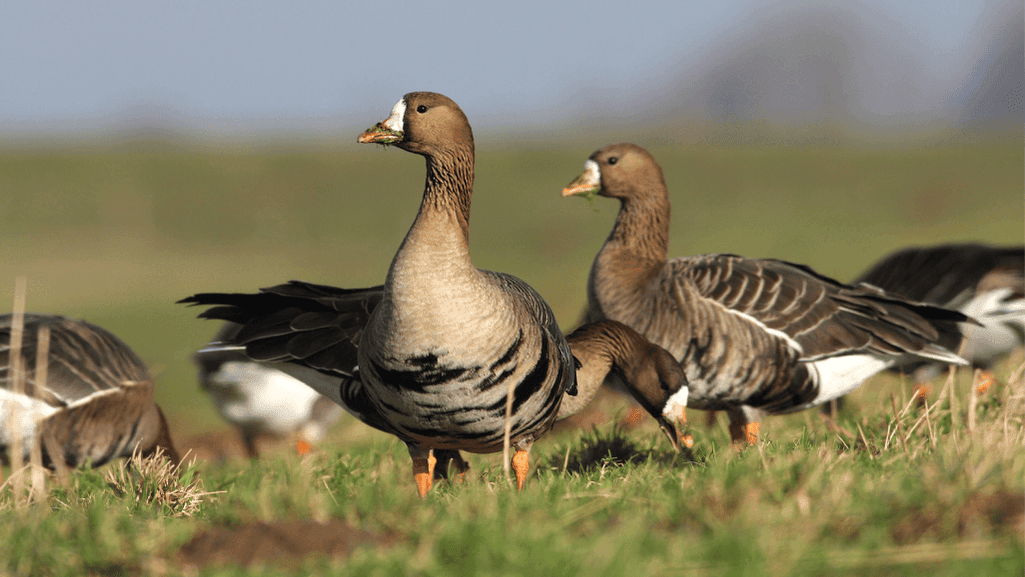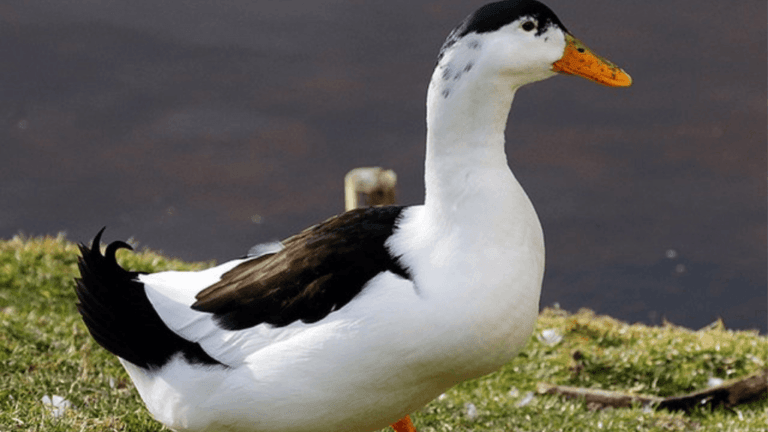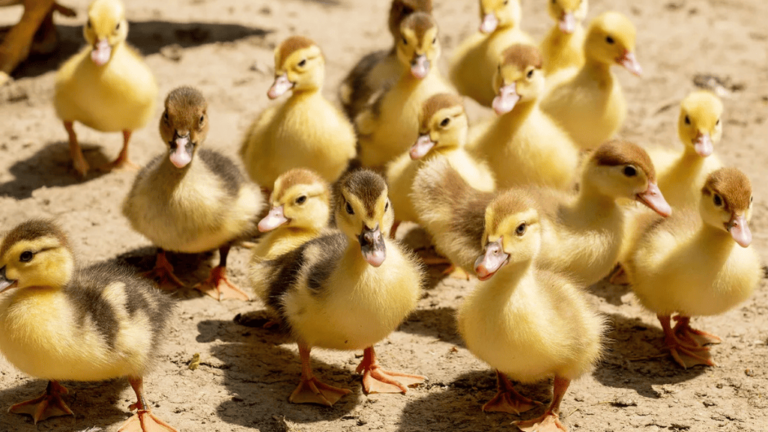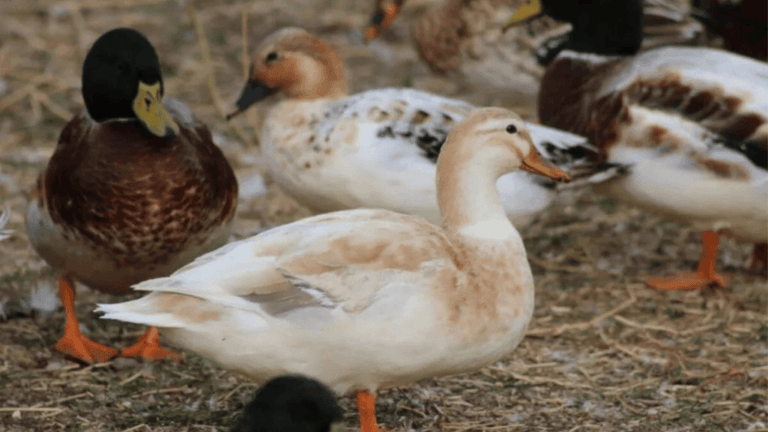The speckle bellied goose, also known as the greater white-fronted goose or Anser indicus, is a favorite among hunters. These medium-sized migratory birds are known for their unique look and the challenge they offer. With a global breeding population of 2.1 million, they are a sought-after game bird in North America’s wetlands.
These geese weigh 5 to 6 pounds and are 27 to 29 inches long. They have broken black barring on their breast and a white patch behind their bill. Their distinctive look and cautious nature make them exciting to hunt. Hunters in the mid-continent area have been retrieving around 81,000 birds each year.
Speckle bellied geese spend their winters in Louisiana, southeast Texas, and southeast Arkansas. To hunt them, it’s important to know their migration patterns and where they like to eat and rest. Hunters use decoys and calls to lure them in, making the hunt both challenging and rewarding.
Key Takeaways:
- Speckle bellied geese are highly prized game birds known for their distinctive appearance and challenging hunting experience.
- The global breeding population of greater white-fronted geese is estimated at 2.1 million, with the mid-continent population around 700,000.
- Hunters retrieve an annual average of 81,000 speckle bellied geese, with the largest wintering flocks found in Louisiana, southeast Texas, and southeast Arkansas.
- Successful hunting requires studying movement patterns, using large decoy spreads, and mastering proper calls to attract speckle bellies.
- The meat of speckle bellied geese is considered superior in taste to other goose species.
Introduction to the Speckle Bellied Goose
The speckle bellied goose, also known as the Greater White-fronted Goose, is a fascinating bird. It has caught the eye of birdwatchers and hunters. This goose is brown and found mainly west of the Mississippi in North America. There are two main populations: the Pacific and the Mid-Continent.
Overview of the Species
The Greater White-fronted Goose has a white bill and black markings on its breast. Adults in western North America have pinkish bills and orange legs. These geese form strong pairs, staying together for years and migrating together.
Some young geese even stay with their parents the next year. This shows the strong family bonds in this species.
The tule subspecies of the Greater White-fronted is larger and darker. It has a small population of about 7,500 in California’s Sacramento Valley. This subspecies is important for conservation due to its limited numbers and specific habitat needs.
Habitat and Distribution
Greater White-fronted Geese live in different places:
- Breeding grounds: Arctic tundra near wetlands, rivers, and ponds
- Wintering grounds: Agricultural fields, marshes, bays, and lakes
- Migration stopovers: Wetlands, lakes, and croplands
From February to May and September to November, these geese can be seen foraging or resting. Their winter months in California, Texas, and Louisiana are great for spotting them. They often gather with Snow and Canada Geese.
The Lesser White-fronted Goose, an Asian goose species, inspired the name “Greater” for the Greater White-fronted Goose. While not currently endangered, the tule subspecies’ small population shows the need for wildlife protection and conservation.
Unique Characteristics of the Speckle Bellied Goose
The speckle bellied goose, also known as the greater white-fronted goose, is a fascinating bird. It has unique traits that make it stand out. These birds migrate early, leaving their Arctic homes in late August. They head to the Gulf Coast for the winter. Speckle bellied geese are rare in North America, except in specific areas.
Physical Features
Adult speckle bellied geese are medium-sized. They are about 28 inches long and have a 60-inch wingspan. They weigh between six and eight pounds. They have brown sides, neck, and head, with a darker brown back and tail.
Their breast is creamy brown with black or dark brown bars. They have a white belly, under-tail, and around the bill. They also have orange legs and a pinkish/orange bill. Their wings are gray with a white U-shape on the rear when flying.
White-front family bonds can last longer than other wild geese. Young geese may stay with their parents for another breeding season. This strong family bond helps the species thrive and adapt.
Distinctive Vocalizations
The speckle bellied goose has a unique voice. It sounds like laughter, earning them the nickname “laughing geese.” This call makes them special for birdwatchers and hunters.
Hunters attract Greater White-Fronted Geese with decoys and imitating their unique calls.
Speckle bellied geese are a trophy for hunters. Bagging a limit of these birds is a big achievement. The global breeding population is about 2.1 million birds.
In the U.S., hunters shot around 269,000 greater white-fronted geese each year from 2012 to 2016. Hunting bag limits for these geese vary by state and zone. This helps conserve the population.
Hunting Speckle Bellied Geese: Tips and Techniques
Speckle bellied geese, also known as white-fronted geese, are highly sought after by hunters. They weigh between 4 to 6 pounds and are known for their caution. To hunt them, you need to be well-prepared and use the right strategies.
Scouting is key when hunting speckle bellied geese. Landowners might let you hunt to protect their winter wheat from geese damage. After getting permission, setting up a large decoy spread is important. Use about two to three dozen decoys, placed 30 to 50 yards from your blind.
Best Hunting Locations
The Central and Mississippi flyways, in states like Arkansas, Louisiana, and Texas, are great for hunting speckle bellied geese. In Western Saskatchewan, hunting packages allow for 8 ducks, 8 dark geese, 5 cranes, and 20 snow geese. You can hunt three times a day.
Essential Gear for Success
Specklebelly calls are essential to attract these geese. Their calls are different from snow or Canada geese. Also, use well-camouflaged blinds and stay hidden. Specklebelly geese are wary, so you must be careful.
Remember, conservation efforts are important for speckle bellied goose populations. Follow hunting rules, use the right gear, and support conservation. This way, you can enjoy hunting while helping these birds thrive.
Speckle Bellied Goose Migration Patterns
The speckle bellied goose, a migratory bird, has a unique speckled belly. It travels from the Arctic to the southern United States and Mexico each year. This journey is long, covering vast distances in search of better living conditions.
On their way, speckle bellied geese stop in key places like the Canadian Prairie Provinces. Here, they rest and build up their energy. They eat agricultural grains to gain the fat they need for the rest of their trip.
Seasonal Movements
Speckle bellied geese start their migration in October and November. They leave the Arctic as winter gets closer. The timing depends on food availability and the cold weather.
As they head south, they follow well-known paths. They travel in huge flocks, filling the sky with their calls. This is a sight to behold.
Impact of Weather on Migration
Weather greatly affects speckle bellied geese migration. Strong winds, storms, and temperature changes can alter their journey.
“The migration of speckle bellied geese is a testament to the resilience and adaptability of these remarkable birds. Despite the challenges they face, they continue to undertake this incredible journey year after year.”
Good weather helps them move quickly. But bad weather can make them change their path or slow down. They seek better conditions to ensure a safe trip.
Culinary Uses of Speckle Bellied Goose
The speckle bellied goose is known for its superior taste. It’s a favorite among hunters and food lovers. This bird offers a unique and flavorful culinary experience through various cooking methods.
Preparing Traditional Dishes
One classic way to enjoy speckle bellied goose is through Wild Goose in Red Wine Gravy. This recipe involves cleaning 2 (4 to 5-pound) wild specklebelly geese. They are brined overnight in a mix of 3 quarts of apple juice and 1 cup of salt.
The dish also uses 6 strips of smoked applewood bacon and a 750 ml bottle of red wine. The wine is reduced by half over 10 to 15 minutes of cooking. The result is a tender, flavorful goose served over 8 cups of cooked long-grain white rice.
Popular Cooking Methods
There are several popular methods to cook speckle bellied goose. Roasting a whole bird at 325°F for 18-20 minutes per pound is a classic method. This yields delicious results.
For a quicker option, the breast meat can be grilled like a steak. This results in a juicy and flavorful dish. The legs and thighs should be braised for optimal tenderness.
Dry-aging the speckle bellied goose breast for 4-5 days before wet-aging for another 10 days enhances its flavor and texture. When cooking the breast, aim for an internal temperature of 115-118 degrees Fahrenheit. Then, rest it for 20-30 minutes to allow for temperature stabilization and optimal juiciness.
Searing the breast for 1-1.5 minutes per side creates a beautifully crisp, golden brown exterior. Pair the goose steak with a flavorful pan sauce made with bourbon, water, Worcestershire sauce, Dijon mustard, and butter for an unforgettable dining experience.
“The key to a perfectly cooked speckle bellied goose is patience and attention to detail. From the brining process to the final sear, each step plays a critical role in showing the bird’s natural flavors.”
Regardless of the cooking method, plucking the bird and rendering the fat during cooking will enhance the flavor of your speckle bellied goose dish. With its versatility and exquisite taste, this wild game bird is sure to impress even the most discerning palates.
Conservation Status and Efforts
The greater white-fronted goose, also known as the specklebelly, is loved by many. Its global population is stable, with about 2.1 million birds. But, some subspecies and regional populations face concerns.
The tule goose, a Pacific flyway subspecies, has only 7,500 birds. It’s a key focus for conservation.
Population trends vary by region and subspecies. In 2010, the North American midcontinent subspecies had around 710,000 birds. The Pacific white-fronted goose had about 650,000. In the British Isles, Greenland birds winter in Scotland and Ireland, while Russian birds are in England and Wales. Ireland hosts nearly 50% of the Greenland population in winter.
Despite overall stability, the Greenland white-fronted goose population has declined. This shows the need for targeted wildlife protection efforts.
Many organizations are working to protect the greater white-fronted goose. Groups like Delta Waterfowl and Ducks Unlimited focus on research, habitat restoration, and advocacy. Hunters also play a key role by following regulations and supporting conservation efforts.
The Role of Hunters in Conservation
Hunters are key in protecting the greater white-fronted goose and other waterfowl. By following hunting rules, they help keep populations healthy. Hunters also support conservation through memberships, donations, and volunteering.
“Hunters are the original conservationists, and their passion for the outdoors drives them to protect the species and habitats they cherish.”
Protecting the greater white-fronted goose requires teamwork. Hunters, conservation groups, and wildlife agencies must work together. By protecting habitats, monitoring populations, and promoting sustainable hunting, we can ensure these birds thrive for future generations.
Final Thoughts on Hunting the Speckle Bellied Goose
As we wrap up our look at the speckle bellied goose, also known as the white-fronted goose, it’s key to think about ethical hunting. These amazing waterfowl, with their unique markings and big wings, draw hunters from all over North America. From California’s Pacific population to Texas and Louisiana’s mid-continent birds, hunting specklebellies needs skill, patience, and respect for the species and its homes.
The Ethical Hunter’s Approach
Ethical hunters believe in fair chase and aim for clean, quick kills. They follow all hunting rules, like bag limits and seasonal bans, to keep specklebelly numbers stable. They also treat birds humanely, using the right gear and methods to lessen pain. By hunting responsibly, like aiming well and quickly picking up downed birds, hunters show they care about the species they hunt.
Contributing to Sustainable Practices
Ethical hunters do more than just hunt; they help conservation and keep waterfowl populations balanced. They join in on habitat projects, like wetland care and farm management, to protect specklebelly homes. They also buy hunting licenses, stamps, and join conservation groups, helping fund research and protection for specklebellies and all birds.
Thinking about the excitement of hunting and the joy of a successful hunt, let’s not forget the bigger reason we hunt speckle bellied geese. By following ethical hunting and supporting conservation, we make sure future hunters can enjoy these incredible birds. Together, we protect the specklebelly and the rich hunting tradition it stands for.
















